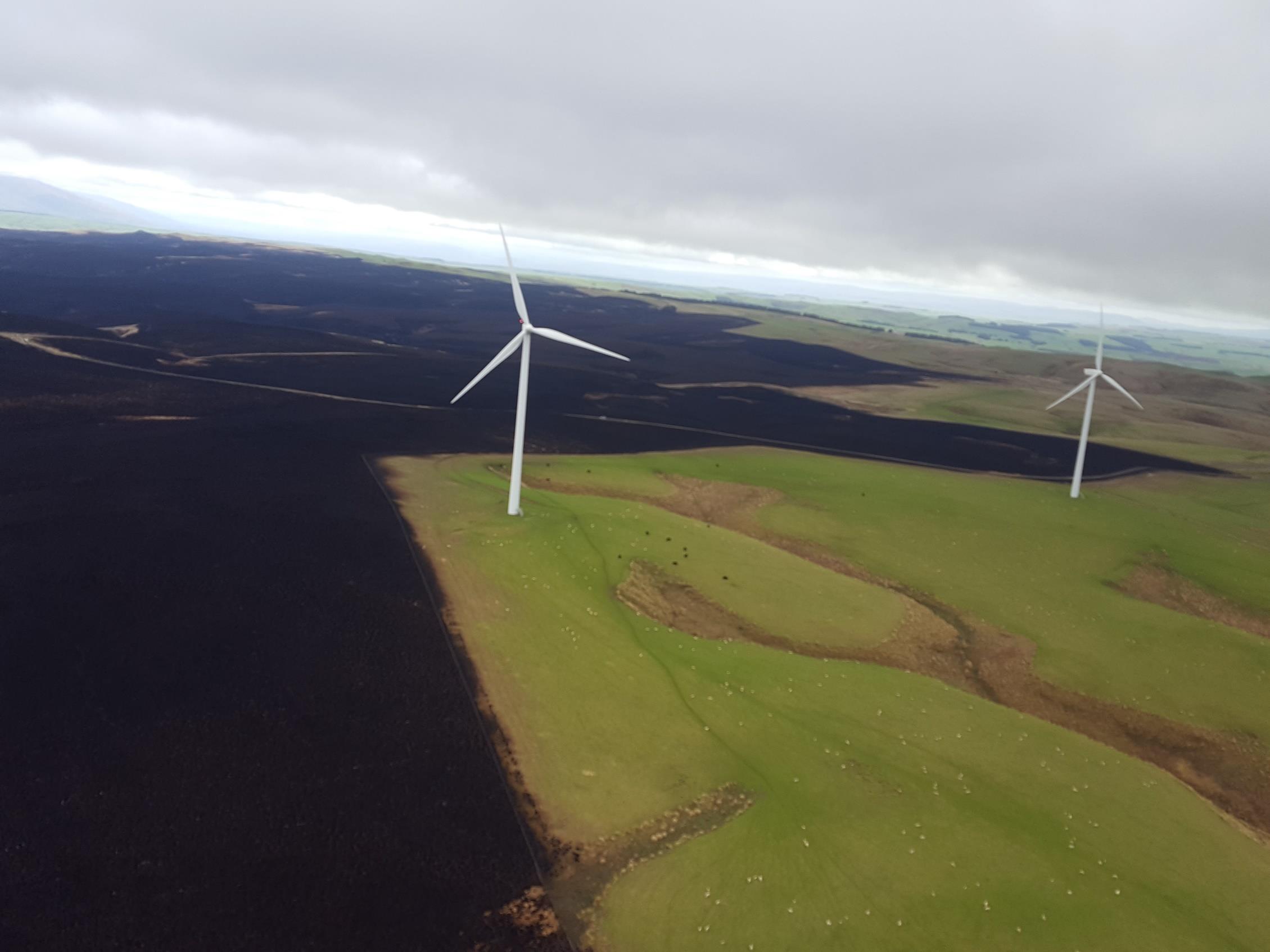
 OPERATIONAL
REVIEW
Vegetation Fire Incident
F2879764
Old Dunstan Road
Middlemarch
OPERATIONAL
REVIEW
Vegetation Fire Incident
F2879764
Old Dunstan Road
Middlemarch
Created by: Operational Efficiency
& Readiness
Mā te mōhio ka anga whakamua
Fire and Emergency NZ NHQ
Date: 9th November 2019
Through knowledge we improve
Contents
1.
Executive Summary ...................................................................................................................... 3
2.
Key Findings .................................................................................................................................. 3
3.
Other Findings .............................................................................................................................. 4
4.
Operational Efficiency and Readiness .......................................................................................... 4
5.
Purpose of Review ........................................................................................................................ 4
6.
Methodology ................................................................................................................................ 5
7.
Review Requested by ................................................................................................................... 5
8.
Review Team ................................................................................................................................. 5
9.
Links .............................................................................................................................................. 6
10.
The Event ...................................................................................................................................... 6
11.
Environment Description .............................................................................................................. 8
12.
Review .......................................................................................................................................... 9
12.1 Reduction ...................................................................................................................................... 9
12.2 Readiness .................................................................................................................................... 12
12.3 Response ..................................................................................................................................... 13
12.4 Recovery ..................................................................................................................................... 19
13.
Conclusion .................................................................................................................................. 20
14.
References .................................................................................................................................. 21
15.
Review Authorisation ................................................................................................................. 22
2
1. Executive Summary
At 10:50 hours on 9 November 2019, the Southern Communications Centre (Comcen) received a
111 call from a Department of Conservation park ranger reporting smoke showing from scrub in
the Te Papanui Conservation Park on the hill side above Deep Stream, South East of Middlemarch
Central Otago.
In terms of land mass this fire was twice the size of the recent Pigeon Valley fires in Nelson. The
location of the fire was very isolated with immediate risk to high valued assets and property. The
high valued assets identified that could become threatened were Dunedin City’s main water supply,
Department of Conservation Te Papanui tussock lands, and a wind farm and Waipori forest.
Local Fire and Emergency New Zealand (Fire and Emergency) management’s familiarity of the
area resulted in a quick appropriate response, and early engagement with key stakeholders
ensured a positive outcome.
Fire and Emergency were engaged with the incident for several weeks despite the fire being on
Department of Conservation (DoC) land and also land of the Dunedin City Council water
catchment. DoC were reluctant to take control of the incident in the later stages once it was
contained and were happy with Fire and Emergency continuing to manage it. The fire was
challenging due to the isolation, challenging terrain, restricted access, and fuel types. During
firefighting operations, there were 11 helicopters and specialised ground crews operating.
The existence and utilisation of a tactical plan developed by the Dunedin City Council (DCC) and
the current PRFO to protect the water supply proved valuable in supporting the appropriate
response and ongoing management of this fire.
There were some challenges with collaboration between the IMT and RCC regarding their purpose
and function which needs to be addressed. There was also an issue with appropriate welfare
management of personnel during high country firefighting and will need to be addressed before
the next fire season.
2. Key Findings
1.
Operational crews were at times working in inclement weather with sub-zero wind chill.
There is a very real potential for firefighters to experience hypothermia from exposure to
such weather conditions. The current rural firefighting PPE doesn’t provide warmth in these
situations.
2.
The Deep Stream water catchment tactical plan was very useful for response for this incident
and contributed to a positive outcome, however did not mention the potential risks to
Dunedin City’s water supply when using fire suppressants during aerial attack with
helicopters with buckets dipping in catchment areas.
3.
Confusion regarding the roles of the IMT and RCC continued to be an issue for the
management of this incident. Location of Fire Behaviour Specialists and PIM functions would
3
have been more effective based at or near the ICP early in the incident. It was noted by the
team that the Fire Behaviour Specialist did relocate later in the incident. The SharePoint
operating platform created confusion for various functions in the IMT and RCC.
4.
The isolation and size of the incident required crews to work at some distance from the ICP
and support in the event of a medical incident. The team found that current medical
equipment carried with ground crews in these situations was insufficient for all potential
medical events.
3. Other Findings
1.
The Otago Rural Fire plan was actively used at this incident and was positively commented
on in the 2019 Validation Audit. However, the plan is not accessible on the portal, as are
most in other Fire and Emergency Districts, however the Fire Plan was accessible in the
command unit upon its arrival and in the responding DPRFO’s vehicles.
2.
Local Fire and Emergency knowledge of the area, the tactical plan and early key stakeholder
engagement supported a positive outcome.
3.
New infrared cameras mounted to helicopters were very useful during the incident for
locating the approximate location of hotspots. Crews were then deployed to complete the
extinguishment.
4.
Current Fire and Emergency applications to support Fire Behaviour Specialists is available
on devices using the Scion Fire Behaviour Toolkit. This was used for initial fire predictions
however overlaying the data onto an application called Fire Mapper and the use of the
application is not available to Fire and Emergency IT system.
5.
A recommendation is for Fire and Emergency to adopt Fire Mapper as a standard application
4. Operational Efficiency and Readiness
The purpose of Operational Efficiency and Readiness (OER) is to provide operational assu rance
advice to the Chief Executive and Executive Leadership Team to ensure they achieve their
responsibilities for the operational efficiency and operational readiness of Fire and Emergency
New Zealand.
OER is independent, objective and provides quality operational assurance advice to support
continuous improvement regarding the operational efficiency and readiness of Fire and Emergency
New Zealand. OER is required to report quarterly to the Fire and Emergency Audit and Risk
Committee and is a function of the Office of the Chief Executive.
5. Purpose of Review
An Operational Review examines how Fire and Emergency responded to large, significant and/or
unusual incidents to provide continuous improvement. While it considers the application of policies,
procedures and operational instructions (as they applied to the incident), its primary focus is to
4
assist Officers and firefighters learning by sharing knowledge and experiences gained through real
incidents.
A review focus’ on the facts and does not provide conjecture or alternative opinions. The review
identifies key findings to inform Senior Managers to develop corrective actions. It also identifies
general findings related to equipment, tactics, and/or actions that worked well to support
organisational learning.
Once completed, all reports are published in the Operational Efficiency Portal page for all to read
and share.
6. Methodology
The review team use the Incident Cause Analysis Method (ICAM) as a guide to conduct operational
reviews. Some of the team members have attained the “Implementing a monitoring, evaluation
and reporting program” qualification (AHCBUS607) through Technical and Further Education
(TAFE), New South Wales, Australia. This process may have been adopted as a means of
capturing information and data for this review.
The content contained within this report is a true and accurate reflection of the information provided
to the team through debriefs, interviews, and data collected by means of Fire and Emergency
reporting systems.
Note, a Fire and Emergency New Zealand login will be required to access most links within this
document.
7. Review Requested by
Mike Grant, Region Manager Te Kei
8. Review Team
Review Lead:
ANC Trevor Brown, National Operational Efficiency Manager
Review Team:
AC Darryl Papesch, Manager Operational Efficiency & Readiness
Review Team:
AAC Steve Trigg, Operational Efficiency & Readiness Advisor
5
9. Links
ICad Report
F2879764
Media Articles
NZ Herald Otago Daily Times Stuff Radio NZ
10. The Event
At 10:50 hours on 9 November 2019, the Comcen received a 111 call from a Department of
Conservation park ranger reporting smoke showing from scrub in the Te Papanui Conservation
Park on the hill side above Deep Stream Water catchment, South East of Middlemarch Central
Otago.
A first alarm VEG response of Millers Flat 347 (MILL347) and Millers Flat 3411 (MILL3411- tanker)
was dispatched, and the Rural Fire Officer Otago 2 (RFO2) was notified and responded to
investigate. The DoC ranger was familiar with the area and informed the Comcen that 4WD access
was not likely to be effective and the closest access was from the direction of Middlemarch. Due
to the limited access, the DoC ranger recommended helicopters as the best option for resourcing
and firefighting due to the isolated location of the fire.
Based on this information the Comcen attached Middlemarch 387 (MIDD387) and Middlemarch
3811 (MIDD3811-Tanker) to the incident and advised the Millers Flat appliances that the incident
was in Middlemarch’s area and they could stand down. The DoC ranger was advised to expect a
call from the RFO who was responding so he could gather further information.
At 11:06 while RFO (2) was still responding to the incident he requested Waihola 6825 (WAIH6825)
and Waihola 6871 (WAIH6871) also be attached to the incident. At 11:16 while still some 30km
from the incident he could observe what he considered a significant fire and transmitted a K66
proceeding. At 11:23 he transmitted a situation report (SitRep) and requested a weather report for
the Te Papanui/Old Dunstan Road for the next 8 hours.
Otago still had an open fire season but the day before this incident a Red Flag day had been
declared by the PRFO. The weather forecast through to 1800 Saturday was for dry northerly winds
from NE to NW at 20-40 Kph, gusting to 60-80 Kph (highest at elevation). Max temperature was
predicted to be 24 degrees and relative humidity 30-40%.
Based on the information from the DoC ranger, the recent high fire season indicators (Friday before
was a ‘Red Flag Day’ and Otago had already had several vegetation fires) and familiarity with the
location and its challenges, the RFO (2) organised 4 helicopters while still responding. The District
team (PRFO and RFO’s) also became aware that the fire was near the Deep Stream Water
catchment which was a main source for the Dunedin City Water Supply. The Dunedin City Council
(DCC) in conjunction with the current PRFO for Fire and Emergency had previously developed a
6
tactical plan which had been recently updated with Fire and Emergency input. The plan also
included firefighting activity, key contacts and predetermined responses. The fire officers were
familiar with it as several had worked for the DCC prior to Fire and Emergency.
As he got closer, the RFO (2) observed a rapid moving fire. Shortly after arriving at the incident
the first of the requested helicopters arrived, so he went for a fly over of the incident to conduct an
initial size up of the fire and gain situational awareness. He observed is was a rapidly moving fire
heading south west toward the wind farm and potentially towards the Waipori forest, and the
eastern flank of the fire was green so would present a low risk. He also observed that there were
a couple of homesteads and some farm sheds that were potential exposure risks from the fire.
Initial tactics were to try to contain the fire to its flanks and protect exposures, including the wind
farm and the Deep Stream water supply. The DPRFO and PRFO took time to engage with
stakeholders that may be involved if the fire grew beyond their control.
At the time this incident was notified, the Dunedin Command Unit was at another incident in
Waikouaiti, approximately 50 km’s north of Dunedin. On request, they were advised it could be
released shortly to respond to the Old Dunstan Road fire.
RFO (2) assumed the role of Incident Controller (IC). With the resources he had at his disposal he
set up an initial IMT comprising an Operations Manager, Safety Officer, Air Attack Supervisor and
Air Support. When the PRFO arrived he assumed the role of Air Attack supervisor as there was
no other qualified person available, leaving RFO (2) as IC. This changed the following day when
another qualified air attack supervisor arrived. The PRFO then assumed the role as IC and
appointed the incumbent IC to the role as Operations Manager.
Following the fly over and size up the Outram Brigade were requested to respond and provide
structure protection at the Wind Farm. Additional support with representatives from DoC, the
Forestry Company, and the DCC Water Department were quickly on scene. The majority of the
land involved was DoC estate but they did not take the lead for this incident. DoC did provide 10
firefighting personnel to assist with the incident.
The conditions encountered were dry and windy, creating a fast moving fire in grass, tussock and
scrub. Much of the first day involved assembling anticipated resources and preparing the overall
strategy and tactics. This was hampered by the speed of the fire requiring constant review of tactics
and positioning of crews. One of the first involved helicopter pilots commented that he was
incredibly surprised by the speed of the fire. When he stopped to refuel not far from where he was
working and returned a short time later, the fire had progressed over a kilometre. So although they
were able to quickly gain situational awareness it still took three to four hours to get all the
resources required and properly set up.
It was clear to the IC that the majority of firefighting was going to need to be done by air attack,
with ground crews used later on for mopping up, as access was going to be difficult by road,
although, crews provided property protection along with helicopters using buckets. At the peak of
the firefighting operation there were 11 helicopters involved. Due to mist on day 2, flying was
7
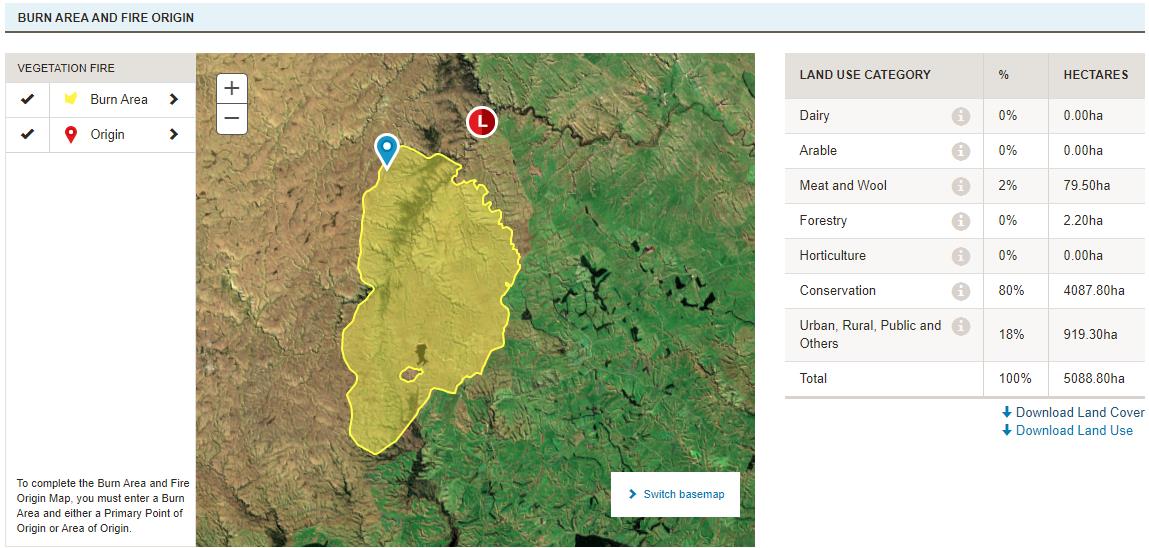
restricted, but in total about a day and a half of fire attack occurred before commencing the mop
up phase. As predicted the mist was able to reduce the spread of the fire, this worked and worked
in favour of the firefighting efforts as it was able to slow the fire due to the moisture uptake in the
predominant fine fuels
Due to the isolation of the fire and lack of suitable facilities a number of the IMT functions were
managed from the RCC facility at the Region HQ. These included Public Information
Management(PIM), Department of Conservation (DoC) liaison, Dunedin City Council Emergency
Management liaison, Planning and Intelligence, Fire Behaviour, and Welfare. The following day
the IMT requested an Iwi representative from Ngai Tahu to ensure they properly considered the
values at risk.
The quick establishment of a well-structured IMT guaranteed a reasonably quick response to food
and hydration supplies and ablution facilities etc. were provided to fire crews. It was also noted
that having communication with the Ranger who had notified the fire ensured the IMT were quickly
able to assess challenges and values at risk.
Due to the size and difficult access of the fire it was officially declared out nearly 6 weeks later, but
the last couple of weeks were mostly monitoring and the occasional mop up crew sent in to
extinguish any hot spots amongst the deep seated peat.
11. Environment Description
The majority of the land involved was retired land that forms DoC estate, and Dunedin City
Coucil Deep Stream water catchment. The outlying areas consist farming and forestry. The main
estate was a retired farm brought by the DCC to preserve the main water supply.
8
12. Review
This section outlines the findings from the operational review investigation based on the
investigation’s terms of reference and expectations. Generally, the findings are grouped
chronologically under the “4Rs” headings Reduction, Readiness, Response and Recovery.
The Operational Review team will measure compliance against Fire and Emergency Operational
Instructions and Policy.
12.1 Reduction
12.1.1 Inter-agency and Stakeholder Relationships
Our expectations
That Fire and Emergency engaged with key stakeholders (building owners, land owners, territorial
authorities, contractors etc), or key partners and stakeholders that support or are engaged with Fire
and Emergency, to discuss reduction activities. Especially as they relate to fire conditions as the fire
risk escalates.
Our findings
The team identified a good relationship between Fire and Emergency, DoC and DCC. They all had
a good understanding of the potential for a fire in this location and its importance in relation to it
being the city’s water supply catchment area. Planning work had been done prior to this event with
all agencies being involved in the process
(ref 12.2.2).
12.1.2 Fire Cause and Determination
Our expectations
That a qualified investigator was assigned to investigate the cause of the fire. Furthermore, a timely
and accurate fire investigation report was published within the expected timeframes.
Our findings
The cause has not been determined although evidence had indicated potential human intervention
.
9
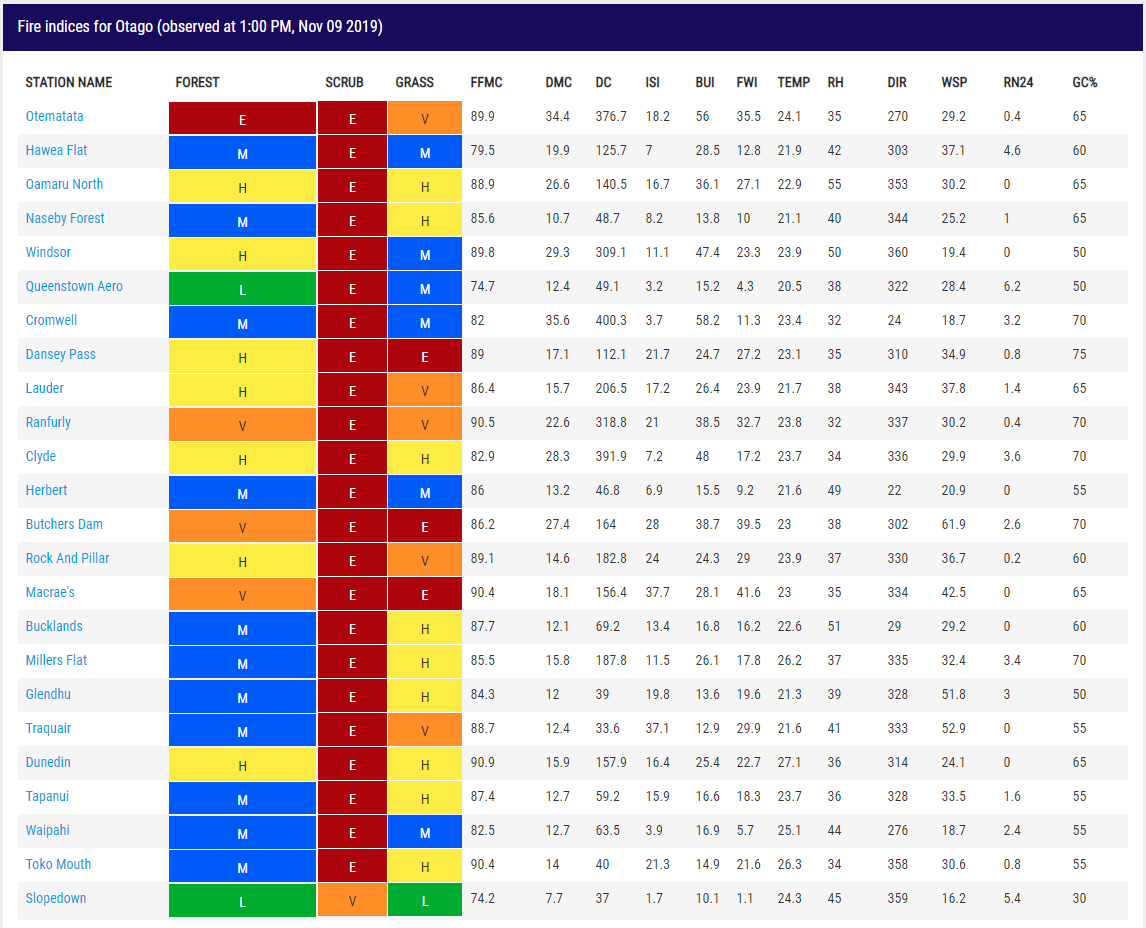
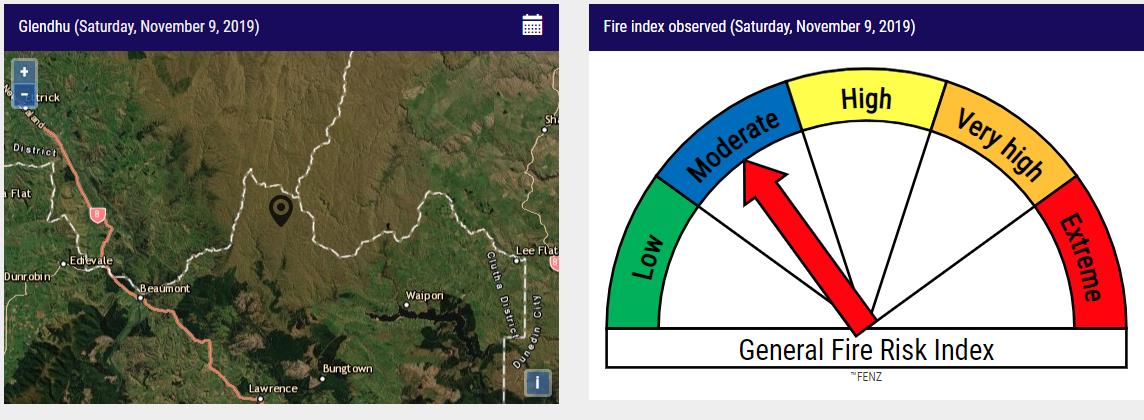
 12.1.3 Fire Season Promotion
Our expectations
12.1.3 Fire Season Promotion
Our expectations
That public signs were maintained and kept
current during the fire season informing the
community and members of the public passing
through aware of the fire danger. Also, the Fire
and Emergency website “Check It’s Alright”
provided current information about the fire season
conditions and permitting information.
Our findings
It was noted by the PRFO that fire prevention
education takes a while to be adopted by the public
as now there are some different permitted activities
that are allowed during the three fire seasons. In
this case the season was Open but a Red Flag
warning was broadcasted prior to this event,
capturing public awareness is a challenge for these
types of days which can happen during any part of the 3 fire seasons
The following information was extracted from the Fire and Emergency
“checkitsalright” website for
the 9 November 2019.
10
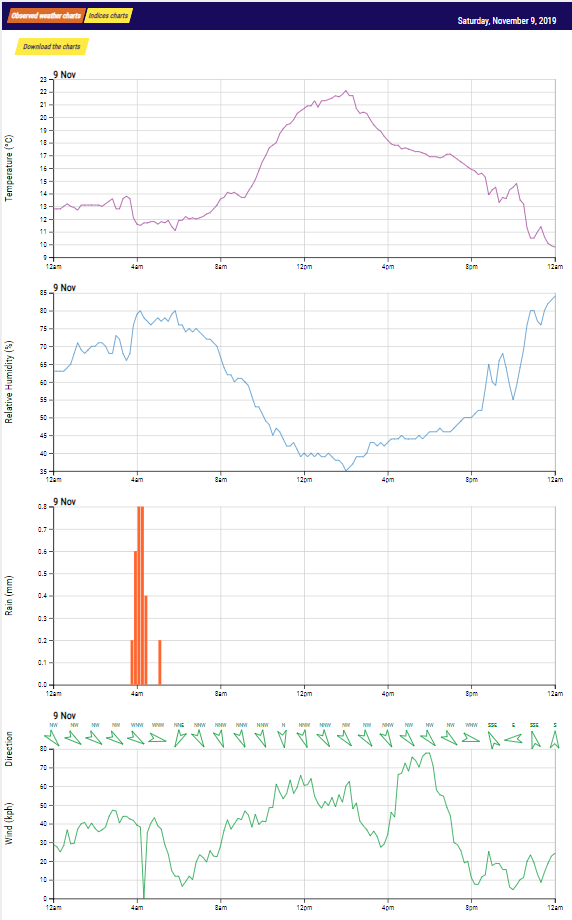
11
12.2 Readiness
12.2.1 Operational Skills Maintenance (OSM) compliance
Our expectations
That all personnel complied with the requirements of the Operational Skills Maintenance
procedures and/or had the appropriate qualifications for the role they performed
Our findings
The OER team had recently conducted an Operational Validation Audit of the Otago Rural Fire
District. They found all rural fire brigades involved to have sufficient personnel appropriately
qualified for this incident. The team did not find any issues with OSM for any other personnel
attending this incident.
12.2.2 Pre-incident Planning and Intelligence
Our expectations
That the Operational Planning process has been followed to identify sites where significant fire or
other risks may indicate the need for a Site Report and/or Tactical Plan. Furthermore, the Fire plan
is current.
Our findings
The team found the District Management was familiar with the area, particularly because of it being
the main water catchment area for Dunedin City. Some of the management had worked for the
DCC prior to Fire and Emergency. A tactical plan created by the DCC pre Fire and Emergency had
been recently updated. Early engagement with DCC and successful due care taken to protect the
Dunedin city water supply was a priority during this incident. However, it was noted by the team
there was no reference to the use of suppressant and its potential risk to the water supply in the
tactical plan.
12.2.3 Water Supplies
Our expectations
That crews had knowledge of, or access to electronic data and/or water maps documenting t he
location of water supplies either reticulated or static for the use of firefighting or decontamination
as prescribed in the Schedule of Operational Readiness Standards.
Our findings
The fire area covered most of Dunedin City’s main water supply, although it was not a traditional
dam water supply, there was ample places for Helicopters to dip their buckets, there were other
sources in the area such as Tarns (naturally formed lakes) on the hill tops.
12
12.3 Response
12.3.1 Initial Mobilisation and Assistance Requests
Our expectations
That the Fire and Emergency Communication Centre and responding appliances meet the
performance expectations as stated in the Service Delivery Guidelines. Furthermore, all message
requests were processed in a timely manner and transmitted in accordance with Land Mobile
Radio Communications procedures
Our findings
The team found no issues with the initial response, it was made clear to the Comcen by the initial
caller (DoC ranger) that it was isolated and would require helicopters to which the operator
deployed accordingly. All other requests were managed in a timely manner and the appropriate
notification’s made as Comcen SOP’s state.
12.3.2 Response Driving and appliance positioning
Our expectations
That Officers and drivers adhere to the principles of Driving policy when responding to the incident.
Furthermore, when positioning the appliance firefighter safety is taken into consideration by
ensuring they are parked away from exposure to fire, building collapse, or other hazards.
Further evaluation of the vehicles locations was given as the incident progressed.
Our findings
During the incident, two near misses were recorded in the Safe@work system. The first was
regarding a Fire and Emergency staff member having a minor accident in his private motor vehicle
while transiting from the fire ground to Middlemarch Fire Station. The incident was investigated by
Fire and Emergency management and a report was generated, actioned and closed in Safe@Work
The second concerned a DoC fire fighter who suffered from mild hypothermia. The person was
assessed at the fire ground and stood down with no ongoing symptoms. DoC management were
notified
Due to the majority of this incident being located quite some distance from any access routes, Fire
and Emergency appliances were not responded into any areas of danger or into any off road
terrain.
12.3.3 Initial Size-up
Our expectations
That the first arriving Officer undertake an initial size-up and risk assessment of the incident site in
line with the principles outlined in the Command and Control Technical Manual.
It is expected the
13
size-up would result in comprehensive situational awareness including hazard identification and
the potential for escalation.
Our findings
The first arriving IC’s initial size-up was done en-route to the incident. He had good knowledge of
the area, along with the initial caller’s information (also known to the IC) and what could already
be seen, he believed the fire was already approximately 80 hectares in size. With the information
gathered so far, four helicopters were immediately requested.
Shortly after his arrival on the incident ground the first helicopter arrived. The IC took the machine
for a fly over of the fireground to gain good situational awareness. Confirming his first thoughts of
air attack and personnel to mop up he started to form the IMT, engage with stakeholders and
prepare for a long duration incident.
The PRFO arrived and filled the position of Air Attack Supervisor until another qualified person
arrived. When the new Air Attack Supervisor arrived the next day, the PFRO took over as IC and
delegated the role of Operations Manager.to the initial IC
12.3.4 Respiratory Protection (BA & APR)
Our expectations
That personnel complied with all aspects of BA and APR, namely but not limited to the Respiratory
Protection Equipment policy, Respiratory Protection Equipment reference guide and the Air
Purifying Respirator guide.
Our findings
No BA or APRs were used during this incident, standard issue P2 masks were carried and used
when required by the rural task forces during the mop up stages.
12.3.5 Hazardous Substance Management
Our expectations
That an incident involving any form of hazardous substance would be managed as prescribed in
Hazardous Materials operational instructions & guidelines and the Hazardous Materials Technical
Manual. Asbestos and other hazards will have been managed as prescribed in the Operational
Safety Policy. Furthermore, the Incident Controller met their responsibilities under the Resource
Management Act 1991, in particular, the discharge of contaminates into the environment.
Our findings
Due to the IMT having sound knowledge of the area involved in fire and the sensitive nature of the
environment within the city’s water supply catchment area, extra caution was applied to avoid any
chemical runoff from the firefighting activities from entering the water supply. Water q uality testing
was carried out during and after the incident to monitor this.
14
12.3.6 Firefighting Mediums
Our expectations
That a high level of operational competence was demonstrated in the selection of firefighting
medium to achieve tactics. Also, that choices were based on a worst-case scenario and/or the
recognition of fire behaviours as prescribed in the Fire Suppression guide.
Our findings
A high level of operational competence was demonstrated across the firefighting operations and
Incident Control functions. This incident was extremely isolated and difficult to access; the initial
tactics was the use of helicopters using buckets and specialised rural teams for mop up. A plan
was put in place for the use of fixed wing aircraft if the incident developed on the second day
The tactics for the first five days was to:
Day one, contain to an area that was manageable.
Day two, unable to resume air attack due to fog. However, this provided ideal conditions
due to tussock grass absorbing moisture which greatly slowed the spread of fire.
Day three, extensive mop up and black out on the western side by 30 metres.
Day four, using an infrared camera on a helicopter to locate hotspots. This was also
repeated on day six including rechecking original hotspots.
Day five revise tactics and extend blackout perimeter.
12.3.7 Operational Competence
Our expectations
That a high level of operational competence was demonstrated across all areas of operations.
Furthermore, all Officers and firefighters performed to their level of training, experience,
qualifications and role they hold within the organisation.
Our findings
A high level of operational competence was demonstrated across the firefighting operations and
Incident Control functions. Due to the incident location and isolation specialised high country
firefighting crews were used to mop up the fire.
12.3.8 Incident Management Team Structure (IMT)
Our expectations
That an incident management team is established for an incident of this magnitude as prescribed
in the Command and Control policy and Technical Manual. It is also expected the structure
implemented would provide clear lines of communication and would be a major contributor to the
successful conclusion of the event.
15
Our findings
The incident structure comprised of:
Incident Control
Operations
Safety Officer
Air Attack Supervisor and Support
Planning and Intel
Fire Behaviour Specialist
An Incident Management Team (IMT) was established in the early stages of this incident once
additional resources arrived at the scene of the fire. This comprised an IC, Operations, Safety, and
Resources, Situation Unit, but it was quickly recognised by managers that this incident, due to its
location, would be difficult to manage and most firefighting would need to be done by Air Attack.
The Command Unit was requested to provide an IMT facility. Unfortunately, this vehicle was at
another incident and took time to arrive. It was noted by the IC that it was difficult to carry out the
functions of the IMT during that period.
The RCC was set up in monitoring mode and became part of the extended IMT with Planning
Manager, PIM and initially fire behaviour specialist. Problems with mapping systems made the fire
behaviour planning difficult to be effective, particularly at a separately located IMT. Therefore, it
was relocated to the command unit at the incident ground.
12.3.9 Incident Ground Facilities and Cordons
Our expectations
That appropriate incident ground facilities and/or cordons were in place to suit the size and
complexity of the event as prescribed in the Command and Control Technical Manual
Our findings
No cordons were required for this event as the valued assets in the area were still some distance
from the fire front.
The command unit lacked space and equipment to operate a full IMT from. Unfortunately, the IMT
was reduced and run from the RCC in Dunedin to compensate. The issues arose over Public
Information management not working well off site. The fire behaviour was relocated to the
operations at the incident, not the PIM.
16
12.3.10 Incident Ground Communications
Our expectations
That an effective communications plan was implemented as prescribed in the Command and
Control Technical Manual. The plan reflects the reporting lines of the IMT and contributed to the
overall safety and effective management of the incident
Our findings
There were no reported issues with any of the communications equipment on the incident ground,
or between the incident ground and RCC.
12.3.11 Senior Officer Notification and Response
Our expectations
That notifications of an escalating incident to the on call Senior Officer and subsequent Senior
Officers reflected the Regions Notifications and Response Policy. Furthermore, upon arrival the
Senior Officer gained situational awareness prior to taking command or mentoring the IC. The IAP
is assessed against current strategy and tactics, priorities are reviewed and managed
appropriately.
Our findings
Appropriate notifications were made to the on-call Senior Officers and their response was timely.
Upon arrival they fulfilled roles that suited their particular skillset which eventually morphed into
the IMT.
12.3.12 Contractor Management
Our expectations
That all contractors used at the incident were identified in the Fire Plan, given a thorough safety
briefing and arrived with or were provided with the appropriate PPE. Furthermore, they were
trained for the tasks expected of them.
Our findings
The main contractors used at this incident were helicopter operators using buckets who were fully
compliant to Fire and Emergency standards to support fire operations.
Fire ground operations employed up to 80 contractors and Volunteers for the mop up with Fire and
Emergency managing the fire ground and resources. Daily briefings were held outlining the day’s
activities and what was to be achieved. All were familiar with the Fire and Emergency safety health
and wellbeing standards and the relevant processes.
17
12.3.13 Incident Ground Safety
Our expectations
That all Fire and Emergency personnel comply with the Health and Safety at Work Act 2015
.
Furthermore, a Safety Officer be appointed in compliance with Operational Safety policy. All
hazards and control measures will be recorded on the Incident Ground Hazard Assessment form
and transferred to a Hazard Assessment Board to manage if available
Our findings
A Safety Officer was appointed in compliance with the requirements contained within IS1. 17
The Safety Officer used the safety officer pack, identified hazards and populated the hazard board.
The hazards were risk assessed and control measures were signed off as being adequate.
12.3.14 Personnel Welfare and Safety
Our expectations
That processes were in place to monitor operational crews for fatigue. This would be managed by
introducing a crew rotation system to share workload.
Our findings
The incident was well managed using very skilled specialist teams selected because of their
familiarity with the environment and conditions they were facing. Crews were deployed according
to their training i.e. high level terrain firefighters working in the field and structure protection crews
protecting dwellings and farm buildings.
It was noted by the investigation team that firefighters working in these isolated locations were not
fully equipped with first aid equipment to handle any medical emergencies they may have faced.
12.3.15 Personal Protective Equipment (PPE)
Our expectations
That all personnel would be dressed in the appropriate level of PPE for the tasks being performed,
as prescribed in the Uniform and PPE policy. Furthermore, the PPE performed to the level
expected and if not, was impounded and reported accordingly
Our findings
The vegetation firefighting PPE (level 1 overalls) were reported as being inadequate for working in
steep terrain during inclement weather that included a sub-zero wind chill. Firefighters suggested
the need for a better selection of appropriate PPE for these environments such as thermal layers,
better wet weather gear and more suitable footwear. There is a limited choice of footwear available
on the Fire and Emergency site and none of it is suitable for high country work.
18
12.4 Recovery
12.4.1 Decontamination Procedures
Our expectations
That any decontamination to Fire and Emergency personnel, other agency personnel and
members of the public be carried out as detailed in the Decontamination policy and procedures.
Our findings
This expectation doesn’t fall within the Terms of Reference, and/or wasn’t required for this event
type, therefore isn’t commented on.
12.4.2 Injuries to Fire and Emergency Personnel
Our expectations
That all work related injuries, near miss, hazardous substance exposure or psychological harm
events to Fire and Emergency Personnel were entered into the Safe@Work site followed by the
appropriate investigations or actions
Our findings
The team were made aware of two events from the incident. One was a firefighter suffering from
a case of mild hypothermia due to working in inclement weather
(ref 12.3.15) and the other was a
minor motor vehicle accident. The team could only find one logged in the Safe@work system. No
outcome has been reported at the time of this review.
12.4.3 Psychological Wellbeing
Our expectations
That the appropriate Psychological Wellbeing support is offered and made available to all
personnel as required. If the opportunity is accepted a follow up of the individual should be initiated.
Our findings
This expectation doesn’t fall within the Terms of Reference, and/or wasn’t required for this event
type, therefore isn’t commented on.
12.4.4 Incident Debrief
Our expectations
That a debriefing of the incident was planned and held in a timely manner. Furthermore, the
debrief was structured enabling all those in key roles at the incident to provide input.
Our findings
The OER team facilitated a high level debrief including representation from DoC and DCC
Emergency Management. A small number of issues between agencies were identified and are
19
being rectified as a result of this discussion. All of the agencies provided the team with answers to
any questions and were happy to participate in the review process.
13. Conclusion
This fire that occurred on an isolated retired farm and DoC land far from any access points posed
several challenges for the initial arriving IC. The fire was primarily in dense tussock grass ,
challenging terrain, and encompassed Deep Stream Water Catchment which is Dunedin city’s
main water supply. Other than the significant conservation land lost, there were few significant high
valued assets exposed to immediate risk of the fire. There was potential threat to a large wind farm
and major forest block if the fire wasn’t brought under control within the first few days.
Furthermore, because of the high winds and fast burning fuel, consideration had to be made for
the potential fire spread towards rural residences and farm buildings within the area.
With sound pre incident planning, familiarity with the area and good information from the initial
caller, the responding IC and PRFO made the good decision to initiate a significant aerial attack
resulting in a positive outcome with almost no loss of property.
There was a fortunate turn in the weather conditions when heavy fog fell, slowing the fire spread
for a period of time.
No personnel were injured during this prolonged incident but a firefighter did show minor
hypothermia symptoms because of the sub-zero temperatures and the current PPE not being
compatible with these conditions.
20
14. References
E3-2 Respiratory Protection
F1 Fire Suppression Guide
FL1 POP Driving Policy
G7 POP Decontamination
G7 SOP Decontamination
G7-1 SOP Post-Fire Decontamination
Hazard Materials (Hazmat) Operations
H1 TM Hazardous Materials Technical Manual
IS1 Operational Safety
M3-2 SOP Land Mobile Radio Communications
M1 POP Command and Control Policy
M1 TM Command and Control Technical Manual
N2 POP Uniform and PPE Policy
N7a Service Delivery Guidelines
New Zealand Resource Management Act 1991, Section 15
OS5 TRP Operational Skills Maintenance
RD2 PRC Operational Planning
RD3 SC Schedule Operational Readiness Standardswww.checkitsalright.nz
Safe@Work
Seek Safety, Health and Wellbeing Support
21



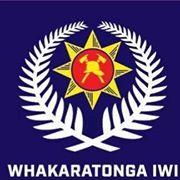
 15. Review Authorisation
15. Review Authorisation
This report has been authorised by Operational Efficiency and Readiness:
Everything in this statement is true to the best of my knowledge and belief, and I made the
statement knowing that it might be admitted as evidence for the purposes of the standard
committal or at a committal hearing and that I could be prosecuted for perjury if the statement is
known by me to be false and is intended by me to mislead.
Trevor Brown
Mike Grant
Assistant National Commander
Region Manager Te Kei
National Operational Efficiency Manager
Review Sponsor
Approved for Publishing
Darryl Digitally signed
by Darryl
Papesch
Papesch Date: 2020.07.02
12:06:34 +12'00'
Follow Us (Click icon):
22











